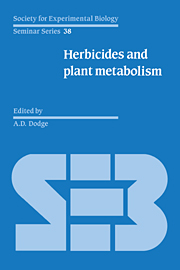Book contents
- Frontmatter
- Contents
- Contributors
- Preface
- Herbicide use and invention
- Herbicides interacting with photosystem II
- Herbicides interacting with photosystem I
- Carotenoids and chlorophylls: herbicidal inhibition of pigment biosynthesis
- Herbicides inhibiting lipid synthesis
- The shikimate pathway as a target for herbicides
- Herbicides that inhibit the biosynthesis of branched chain amino acids
- Glutamine synthetase and its inhibition
- Metabolism of herbicides – detoxification as a basis of selectivity
- Bioactivated herbicides
- Mechanisms involved in the evolution of herbicide resistance in weeds
- Conferring herbicide resistance on susceptible crops
- Herbicide glossary
- Herbicide index
- General index
Metabolism of herbicides – detoxification as a basis of selectivity
Published online by Cambridge University Press: 04 August 2010
- Frontmatter
- Contents
- Contributors
- Preface
- Herbicide use and invention
- Herbicides interacting with photosystem II
- Herbicides interacting with photosystem I
- Carotenoids and chlorophylls: herbicidal inhibition of pigment biosynthesis
- Herbicides inhibiting lipid synthesis
- The shikimate pathway as a target for herbicides
- Herbicides that inhibit the biosynthesis of branched chain amino acids
- Glutamine synthetase and its inhibition
- Metabolism of herbicides – detoxification as a basis of selectivity
- Bioactivated herbicides
- Mechanisms involved in the evolution of herbicide resistance in weeds
- Conferring herbicide resistance on susceptible crops
- Herbicide glossary
- Herbicide index
- General index
Summary
Introduction
Herbicides recommended for the selective control of unwanted weeds have been developed to exploit a difference in phytotoxicity between species adequate to kill competing weeds without significantly reducing crop yields. In some cases the margin of selectivity may be quite modest and can be rendered inadequate when the timing of application coincides with unfavourable climatic conditions, as was reported to be the case for some of the phenylureas in winter wheat in Autumn 1983. There are a number of factors which can contribute to herbicide selectivity including soil placement, rates of absorption and subsequent translocation, localisation (both within the plant and at the sub-cellular level) and transformation to products of modified phytotoxicity. In addition studies made with atrazine-resistant biotypes of such weed species as Chenopodium album and Amaranthus hybridus L. (Steinback, Pfister & Arntzen, 1982) have highlighted the importance of differences in sensitivity of the target site, in this case the 32 kD protein component of photosystem II. It is likely that other examples of reduced target site sensitivity will be encountered when biotypes resistant to herbicides with different modes of action emerge. Differences in target site sensitivity as a basis for selectivity has been considered previously by Gressel (1985) and is also referred to elsewhere in this volume (Chapters 2, 11 and 12).
The selective properties of herbicides often result from a complex interaction of a number of the factors listed above though there are many examples where one dominant factor has been implicated.
- Type
- Chapter
- Information
- Herbicides and Plant Metabolism , pp. 171 - 198Publisher: Cambridge University PressPrint publication year: 1990
- 2
- Cited by

